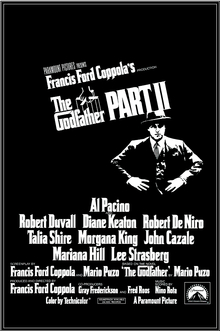| The Godfather Part II | |
|---|---|
 Theatrical release poster | |
| Directed by | Francis Ford Coppola |
| Screenplay by |
|
| Based on | The Godfather by Mario Puzo |
| Produced by | Francis Ford Coppola |
| Starring | |
| Cinematography | Gordon Willis |
| Edited by | |
| Music by | |
Production companies |
|
| Distributed by | Paramount Pictures |
Release dates |
|
Running time | 200 minutes [1] |
| Country | United States |
| Languages |
|
| Budget | $13 million [2] [3] |
| Box office | $93 million [N 1] |
The Godfather Part II is a 1974 American epic gangster film produced and directed by Francis Ford Coppola, loosely based on the 1969 novel The Godfather by Mario Puzo, who co-wrote the screenplay with Coppola. It is both a sequel and a prequel to the 1972 film The Godfather , presenting parallel dramas: one picks up the 1958 story of Michael Corleone (Al Pacino), the new Don of the Corleone family, protecting the family business in the aftermath of an attempt on his life; the other covers the journey of his father, Vito Corleone (Robert De Niro), from his Sicilian childhood to the founding of his family enterprise in New York City. The ensemble cast also features Robert Duvall, Diane Keaton, Talia Shire, Morgana King, John Cazale, Marianna Hill and Lee Strasberg.
Contents
- Plot
- Vito
- Michael
- Cast
- Production
- Development
- Casting
- Filming
- Music
- Release
- Theatrical
- Home media
- Reception
- Box office
- Critical response
- Critical re-assessment
- Accolades
- American Film Institute recognition
- Notes
- References
- External links
Following the first film's success, Paramount Pictures began developing a follow-up, with many of the cast and crew returning. Coppola, who was given more creative control, had wanted to make both a sequel and a prequel to The Godfather that would tell the story of Vito's rise and Michael's fall. Principal photography began in October 1973 and wrapped up in June 1974. The Godfather Part II premiered in New York City on December 12, 1974, and was released in the United States on December 20, 1974. It grossed $48 million in the United States and Canada and up to $93 million worldwide on a $13 million budget. The film was nominated for eleven Academy Awards and became the first sequel to win Best Picture. Its six Oscar wins also included Best Director for Coppola, Best Supporting Actor for De Niro, and Best Adapted Screenplay for Coppola and Puzo. Pacino won Best Actor at the BAFTAs and was nominated at the Oscars.
The Godfather Part II is considered to be one of the greatest films of all time, as well as a rare example of a sequel that rivals its predecessor. [4] Like its predecessor, Part II remains a highly influential film, especially in the gangster genre. In 1997, the American Film Institute ranked it as the 32nd-greatest film in American film history and it retained this position 10 years later. [5] It was selected for preservation in the US National Film Registry of the Library of Congress in 1993, being deemed "culturally, historically, or aesthetically significant". [6] Pauline Kael wrote: "The Godfather was the greatest gangster picture ever made, and had metaphorical overtones that took it far beyond the gangster genre. In Part II, the wider themes are no longer merely implied. The second film shows the consequences of the actions in the first; it’s all one movie, in two great big pieces, and it comes together in your head while you watch." [7]
The Godfather Part III , the final installment in the trilogy, was released 16 years later in 1990.

